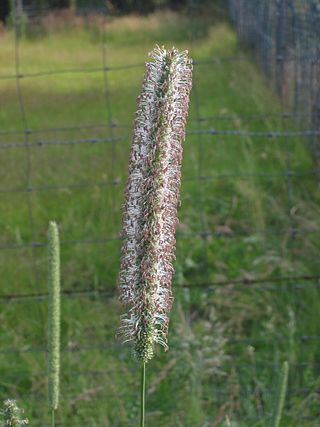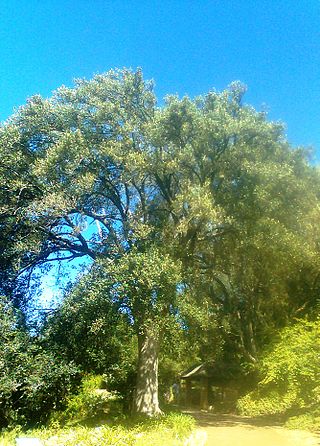
Avicennia is a genus of flowering plants currently placed in the bear's breeches family, Acanthaceae. It contains mangrove trees, which occur in the intertidal zones of estuarine areas and are characterized by its "pencil roots", which are aerial roots. They are also commonly known as api api, which in the Malay language means "fires", a reference to the fact that fireflies often congregate on these trees. Species of Avicennia occur worldwide south of the Tropic of Cancer.

Phleum is a genus of annual and perennial plants in the grass family. The genus is native to Europe, Asia and north Africa, with one species also in North and South America.

Afzelia xylocarpa is a tree from Southeast Asia. It grows in Thailand, Vietnam, Cambodia, Laos and Burma in deciduous forests. It can reach 30 metres tall with a trunk up to 2 metres in diameter in a mature specimen.

Hemithrinax is a genus of palms that is endemic to eastern Cuba. It comprises three species and one variety and was previously included within the genus Thrinax.

Pterocarpus macrocarpus, or Burma padauk, is a tree native to the seasonal tropical forests of southeastern Asia: in Myanmar, Laos, Cambodia, Thailand, and Vietnam. It has been naturalized in India and the Caribbean.

Rodrigo Bernal González is a Colombian botanist who specialises in the palm family. Bernal was a faculty member at the Institute of Natural Sciences, National University of Colombia until 2007. He received his Ph.D. from the University of Aarhus, Denmark, in 1996. He was general curator of the National Colombian Herbarium (1986-1987), and editor of the scientific journal Caldasia.

Ocotea porosa, commonly called imbuia or Brazilian walnut, is a species of plant in the Lauraceae family. Its wood is very hard, and it is a major commercial timber species in Brazil.

Butomus is the only known genus in the plant family Butomaceae, native to Europe and Asia. It is considered invasive in some parts of the United States.
Gloria Amparo Galeano Garcés was a Colombian botanist and agronomist specializing in the palm family. Galeano was a faculty member at the National University of Colombia, and was the director of the Institute of Natural Sciences from 2003 to 2006. She received her Ph.D. from the University of Aarhus, Denmark in 1997.

Assisted natural regeneration (ANR) is the human protection and preservation of natural tree seedlings in forested areas. Seedlings are, in particular, protected from undergrowth and extremely flammable plants such as Imperata grass. Though there is no formal definition or methodology, the overall goal of ANR is to create and improve forest productivity. It typically involves the reduction or removal of barriers to natural regeneration such as soil degradation, competition with weeds, grasses or other vegetation, and protection against disturbances, which can all interfere with growth. In addition to protection efforts, new trees are planted when needed or wanted. With ANR, forests grow faster than they would naturally, resulting in a significant contribution to carbon sequestration efforts. It also serves as a cheaper alternative to reforestation due to decreased nursery needs.

Chukrasia tabularis, the Indian mahogany, is a deciduous, tropical forest tree species in the family Meliaceae. It is native to Bangladesh, Cambodia, China, India, Indonesia, Laos, Malaysia, Myanmar, Sri Lanka, Thailand, and Vietnam. Also introduced to many western countries such as Cameroon, Costa Rica, Nigeria, Puerto Rico, South Africa, and United States.

Kiggelaria africana is a large, robust, low-branching African tree, and is currently the only accepted species in the genus Kiggelaria.

Lumnitzera racemosa, commonly known as the white-flowered black mangrove, is a species of mangrove in the family Combretaceae. It is found on the eastern coast of Africa and other places in the western Indo-Pacific region. It has one accepted variety from the noniminate species which is Lumnitzera racemosa var. lutea (Gaudich.) Exell.

Betula alnoides is a species of birch that can be found in natural condition of such countries as Bangladesh, Bhutan, Cambodia, China, India, Laos, Myanmar, Nepal, Thailand and Vietnam at an elevation of 300–2,100 metres (980–6,890 ft) and higher in some cases. It is the southernmost of all known birch species, whose natural range reaches approximately 12° N in Cardamom Mountains, Cambodia.

Sterculia murexHemsl. or lowveld chestnut is a southern African tree with a very limited distribution in the lowveld of eastern Mpumalanga and Eswatini. After S. alexandri it is the most southern representative of the genus in Africa. Kew currently recognises some 92 species of Sterculia, confined to the tropics and slightly beyond at low elevations.
Homalium brevidens is a shrub or tree species in the family Salicaceae, found in Laos and Cambodia.
Terminalia cambodiana is a species of tree in the family Combretaceae, growing some 6–15 m tall with whitish-grey, exfoliating bark and large greenish branches. It is found in flooded forest communities of Cambodia and southern Vietnam.
Gluta cambodiana is a shrub/small tree in the family Anacardiaceae. It occurs in parts of Mainland Southeast Asia. Its wood is used for pickets and fuel.
Diospyros cambodiana is a tree in the Ebenaceae family, endemic to the Mekong basin, Cambodia. It grows some 15-20m tall in flooded/swamp forest. One of its vernacular names derives from the perceived likeness of its flowers to mouse droppings. The plant is used for construction, craftwork, firewood and medicine.
Liquidambar cambodiana, commonly known as sdey, is a tree in the Altingiaceae family endemic to south west Cambodia.













